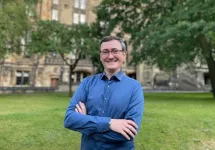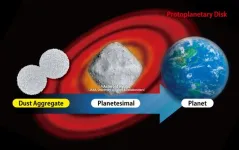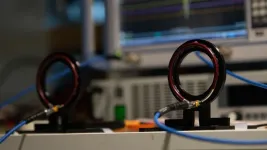(Press-News.org) Researchers at Baylor College of Medicine and collaborating institutions are developing a strategy to predict the response of triple negative breast cancer (TNBC) to chemotherapy, which would be a valuable tool for physicians deciding on the treatment with better probability of success on an individual basis. The study appears in Cancer Research Communications, a journal of the American Association for Cancer Research.
“Multiple research innovations in cancer diagnostics are on display in this work,” said co-corresponding author Dr. Matthew Ellis, member of the Lester and Sue Smith Breast Center and the Dan L Duncan Comprehensive Cancer at Baylor and also senior vice president of early oncology and oncology R&D at AstraZeneca.
The researchers used a laboratory assay called Kinase Inhibitor Pulldown Assay, or KIPA, to search for proteins they could target to control tumor growth. They searched for these proteins in 43 frozen tumor biopsies that were part of the previous Clinical Proteomic Tumor Analysis Consortium (CPTAC)-TNBC study.
“Our initial goal was to find new ways to control TNBC growth, specifically by identifying and then inhibiting enzymes called kinases produced by the tumor to assist on its growth,” said co-corresponding author Dr. Meenakshi Anurag, assistant professor of medicine at the Lester and Sue Smith Breast Center at Baylor. “Although our search for such kinases did not produce valuable candidates, it unexpectedly revealed an opportunity to improve the success of chemotherapy.”
KIPA works by coating tiny beads with selective kinase inhibitors, then breaking down the cells in the biopsy samples and mixing them with the beads. Each kinase binds to its specific inhibitor, effctively separating it from other cell components, though some kinases can bind to multiple inhibitors. Then, the researchers collect and wash the beads, obtain the kinases and use mass spectrometry to identify each one of them.
“This approach did not reveal kinases we could potentially target to control these tumors’ growth; however, the assay captured seven non-kinase proteins, specifically purine-binding proteins, that were enriched in tumors that completely responded to treatment,” said first author Junkai Wang, a graduate student working in the Ellis lab. “Further analyses showed that this seven-purine-binding protein signature predicted chemotherapy sensitivity and favorable clinical outcomes.”
“The purine binding signature could help identify a subset of TNBC patients who should receive investigational therapy from the outset rather than an ineffective standard chemotherapy approach,” Ellis said.
“Although originally KIPA was developed for the accurate quantification of druggable kinases, this paper demonstrates that its clinical utility extends beyond kinase quantification. With more clinical sample analysis, there is a great possibility that we will be able to identify additional signatures for many therapeutic strategies,” said co-corresponding author Dr. Beom-Jun Kim, member of the Lester and Sue Smith Breast Center and the Dan L Duncan Comprehensive Cancer at Baylor and also associate director of diagnostic proteomics at AstraZeneca.
“We are excited about these findings, which we have validated in multiple TNBC cohorts,” Anurag said. “In addition, KIPA offers other advantages: it produces results in a time-efficient manner and requires a much smaller tumor sample than other methods. The purine-binding protein signature we have identified has the potential to contribute to clinical trials designed to either escalate or de-escalate therapy by predicting the probability of chemotherapy success.”
Other contributors to this work include Alexander B. Saltzman, Eric J. Jaehnig, Jonathan T. Lei, Anna Malovannaya, Matthew V. Holt, Meggie N. Young, Mothaffar F. Rimawi and Foluso O. Ademuyiwa. The authors are affiliated with one or more of the following institutions: Baylor College of Medicine, Lester and Sue Smith Breast Center and Dan L Duncan Comprehensive Cancer Center at Baylor, Siteman Comprehensive Cancer Center and Washington University School of Medicine - St. Louis and AstraZeneca.
This work was supported by the CPRIT Recruitment of Established Investigators Award (RR140033), NIH/NCI CPTAC (U01CA214125), NIH/NCI Breast SPORE grant (P50 CA186784), NCI-SPORE Career Enhancement and Developmental Research award (part of P50 CA186784-06) and Translational Breast Cancer Research Training Program grant T32CA203690. Further support was provided by the Dan L Duncan Comprehensive Cancer Center Award (P30 CA125123) and CPRIT Core Facility Awards (RP170005 and RP210227) to BCM Mass Spectrometry Proteomics Core and NIH/NCI K12 Award (CA167540). This work was also supported by generous gifts from the Korell family and Lisa and Ralph Eads, and a McNair Scholar with additional support by the McNair Medical Institute at The Robert and Janice McNair Foundation.
###
END
KIPA potentially predicts chemotherapy response in triple negative breast cancer
2023-07-21
ELSE PRESS RELEASES FROM THIS DATE:
On the hunt for strangeness
2023-07-21
NEWPORT NEWS, VA – Peter Hurck has been searching for strange particles, named such because they contain strange quarks, since beginning work on his Ph.D. As the 2023 Jefferson Science Associates (JSA) Postdoctoral Prize winner, he’ll continue conducting data analyses to identify strange particles and learn about their properties.
Many of these experiments that contribute to the data Hurck is analyzing are conducted at the U.S. Department of Energy's Thomas Jefferson National Accelerator Facility, which is managed and operated by JSA.
“Strangeness hasn't been studied as much because it's quite ...
ASBMB expresses concerns on proposed NIH budget cuts
2023-07-21
On July 19, the American Society for Biochemistry and Molecular Biology released a statement expressing concerns on the National Institutes of Health budget proposed in the House Labor, Health and Human Services, Education and Related Agencies funding bill. The bill allocates only $44.7 billion for NIH, which represents a 6.4% decrease from fiscal year 2023 levels and would have detrimental repercussions for the National Institute of Allergy and Infectious Diseases, the National Institute of Neurological Diseases and Stroke, the National Cancer Institute and the National Institute ...
To stick or to bounce: Size determines the stickiness of cosmic dust aggregates
2023-07-21
Microparticle dust aggregates, which are thought to play a role in the formation of new planets, are less likely to stick together after a collision when the aggregates are larger.
Current evidence suggests that microparticles of cosmic dust collide and stick together to form larger dust aggregates that may eventually combine and develop into planets. Numerical models that accurately characterize the conditions required for colliding microparticle aggregates to stick together, rather than bounce apart, are therefore ...
Long-term changes in waves and storm surges have not impacted global coastlines
2023-07-21
Changes in ocean wave and storm conditions have not caused long-term impacts on sandy coastlines in the past 30 years, a new study has found.
Published today in Scientific Reports, the study draws on data from 30 years of global satellite and model studies to investigate whether changes in ocean wave conditions will have an impact on the stability of coastal environments.
The compounding effect of climate change driven variations in waves, storm surge and sea level rise is projected to lead to shoreline position change along most of the world’s sandy coasts.
A team ...
Subseasonal transition of sea-ice anomalies in the Barents–Kara Sea in winter modulated by the “warm Arctic–cold Eurasia” pattern
2023-07-21
The “warm Arctic–cold Eurasia” is one of the most significant patterns of winter climate system changes in the mid-high latitudes of the Northern Hemisphere. In winter 2020/21, this large-scale pattern underwent a significant and intense subseasonal reversal between the early and late winter. At the same time, the sea-ice anomalies in the Barents–Kara Sea changed from being significantly negative in early winter to positive in late winter. For the slow-varying process of winter sea ice, the rapid freezing ...
Miocene period fossil forest of Wataria found in Japan
2023-07-21
An exquisitely preserved fossil forest from Japan provides missing links and helps reconstruct a whole Eurasia plant from the late Miocene epoch.
Complete plant fossils are seldom found as a single piece, as wood, leaves, flowers, fruits, seeds, or pollen detach easily from plants. This results in leaves and trunks having separate scientific names. Putting together the different parts to reveal the complete plant is like putting together a jigsaw puzzle. Connecting these dots and reconstructing plants is important to establish their taxonomic identity—their ...
Going the distance for better wireless charging
2023-07-21
A better way to wirelessly charge over long distances has been developed at Aalto University. Engineers have optimized the way antennas transmitting and receiving power interact with each other, making use of the phenomenon of “radiation suppression”. The result is a better theoretical understanding of wireless power transfer compared to the conventional inductive approach, a significant advancement in the field.
Charging over short distances, such as through induction pads, uses magnetic near fields to transfer power with high efficiency, but at longer distances the efficiency dramatically drops. New research shows that this high efficiency ...
Are shared medical appointments the key to solving global healthcare shortages?
2023-07-21
This research was conducted by Nazlı Sönmez, ESMT Berlin; Kavitha Srinivasan and Rengaraj Venkatesh, Aravind Eye Hospital (India); Ryan W. Buell, Harvard Business School; and Kamalini Ramdas, London Business School. The researchers wanted to understand the impact of shared medical appointments on patient experience (knowledge gained and satisfaction) and behavior (follow-up rates and medication compliance rates).
In shared medical appointments (SMAs), patients with the same medical condition meet with the physician in a group, with each patient receiving attention in turn. The physician shares information customized to a patient’s specific needs as well ...
HKUMed finds metformin could promote healthy ageing based on genetics
2023-07-21
A research team from the School of Public Health, LKS Faculty of Medicine of the University of Hong Kong (HKUMed), provides genetic evidence that metformin might promote healthy ageing using a cohort study of more than 300,000 participants of European descent (UK Biobank). This proof-of-concept work supports further clinical research into the drug repositioning of metformin in healthy longevity. The findings are now published in The Lancet Healthy Longevity, a leading peer-reviewed, international journal in the field of geriatrics and gerontology [link to the publication].
Background
Metformin is a first-line medication for type 2 diabetes. ...
Important update on use of trabecular bone score (TBS) in clinical practice
2023-07-21
A new position paper presents an up-to-date review and expert recommendations using the GRADE methodology to inform the implementation of trabecular bone score (TBS)* in clinical practice for the management of primary and secondary osteoporosis.1
TBS is a grey-level scale textural measurement acquired from dual-energy X-ray absorptiometry lumbar spine images that correlates with bone microarchitecture and which can be used alongside FRAX and bone mineral density measurements to enhance the assessment of fracture risk and to inform treatment initiation and monitoring.
The position paper was authored by an international ...





